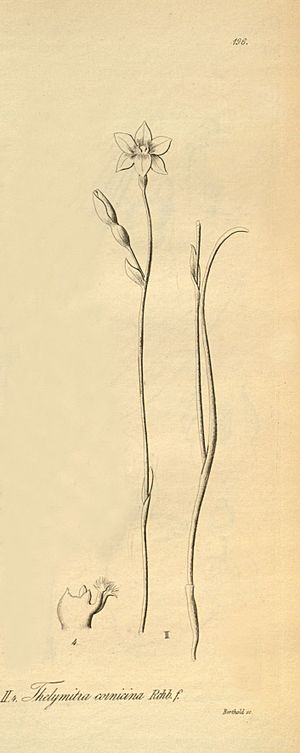Lilac sun orchid facts for kids
Quick facts for kids Lilac sun orchid |
|
|---|---|
 |
|
| Illustration from Reichenbach's Xenia Orchidacea | |
| Scientific classification | |
| Genus: |
Thelymitra
|
| Species: |
cornicina
|
| Synonyms | |
|
|
The lilac sun orchid, scientifically called Thelymitra cornicina, is a type of orchid flower. It is part of the Orchidaceae family. This special plant is only found in the south-west area of Western Australia. It has one thin, light green leaf. Its flowers are usually blue with a hint of lilac. The top part of the flower's anther (which holds pollen) has short, finger-like bumps called calli.
Contents
What the Lilac Sun Orchid Looks Like
The Thelymitra cornicina is a tuberous plant, meaning it grows from a round, underground stem like a potato. It is also a perennial herb, which means it lives for more than two years and does not have a woody stem.
Each plant has one pale green leaf. This leaf is about 10 to 20 centimeters (4 to 8 inches) long and 3 to 5 millimeters (0.1 to 0.2 inches) wide.
The plant can have up to eight flowers. These flowers are pale blue to dark blue, often with a lilac color. Each flower is about 2.5 to 3 centimeters (1 to 1.2 inches) wide. They grow on a stem that is 20 to 50 centimeters (8 to 20 inches) tall.
The sepals and petals of the flower are about 1 to 1.5 centimeters (0.4 to 0.6 inches) long. They are also about 6 to 8 millimeters (0.2 to 0.3 inches) wide.
The column is a special part in the center of the orchid flower. It is blue with a yellow top part. This column is about 3.5 to 4.5 millimeters (0.14 to 0.18 inches) long and 2 millimeters (0.08 inches) wide.
The top part of the anther has short, yellow, finger-like glands. The side parts of the column have small, mop-like bunches of white to lilac hairs.
These flowers are pollinated by insects. They only open up on sunny days. You can usually see them flowering from September to November.
How it Got its Name
The Thelymitra cornicina was first officially described in 1871. This was done by a scientist named Heinrich Gustav Reichenbach. He wrote about it in a book called Beitrage zur Systematischen Pflanzenkunde.
The second part of its scientific name, cornicina, comes from a Latin word. It means "having a horny sheath." This likely refers to a feature of the flower.
Where the Lilac Sun Orchid Lives
The lilac sun orchid grows in areas with scrubland and forest. You can find it between the cities of Perth and Hopetoun in Western Australia.
It lives in several different natural areas. These include the Esperance Plains, Jarrah Forest, Swan Coastal Plain, and Warren biogeographic regions.
Protecting the Lilac Sun Orchid
The Western Australian Government's Department of Parks and Wildlife has looked at the Thelymitra cornicina. They have classified it as "not threatened." This means it is not currently in danger of disappearing.
See also
 In Spanish: Thelymitra cornicina para niños
In Spanish: Thelymitra cornicina para niños

